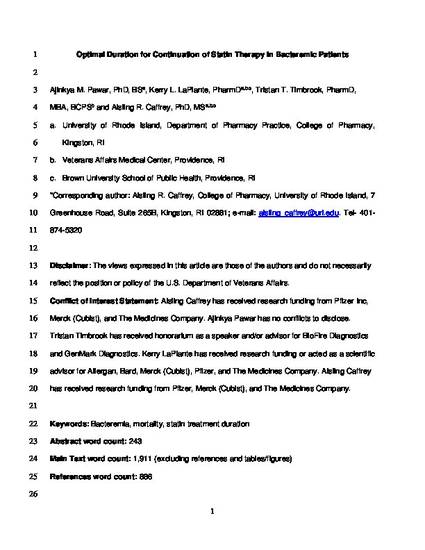
Background: Evidence suggests statins may improve survival in patients with bloodstream infections. However, there is no consensus on optimal timing and duration of exposure.
Objectives: To quantify statin therapy duration associated with decreased mortality in bacteremic statin users.
Methods: We conducted a case-control study using OptumClinformatics™ with matched Premier hospital data (1 October 2009–31 March 2013). Cases who died during the hospitalization were matched 1:1 to survivors on disease risk scores (DRSs). Post-admission statin therapy duration was evaluated in patients with at least 90 days of pre-admission continuous statin use. Classification and regression tree (CART) analysis was conducted to identify the optimal duration of statin continuation which provided the lowest inpatient mortality. Logistic regression was used to calculate the odds of mortality.
Results: We included 58 DRS matched pairs of cases and controls: 47 patients (41%) continued statin therapy during the hospital admission, 15 (32%) cases and 32 (68%) controls. The CART analysis partitioned the continuation of statin therapy at ⩾2 days, representing lower mortality for patients who continued statins for 2 days or more and higher mortality for patients who did not continue or remained on statins for only 1 day. Inpatient mortality was 76% lower among those with at least 2 days of continued statin use (odds ratio 0.24, 95% confidence interval 0.11–0.55).
Pawar, A. M., LaPlante, K. L., Timbrook, T. T., & Caffrey, A. R. (2018). Optimal duration for continuation of statin therapy in bacteremic patients. Therapeutic Advances in Infectious Disease, 83–90. https://doi.org/10.1177/2049936118775926
Available at: https://doi.org/10.1177/2049936118775926
